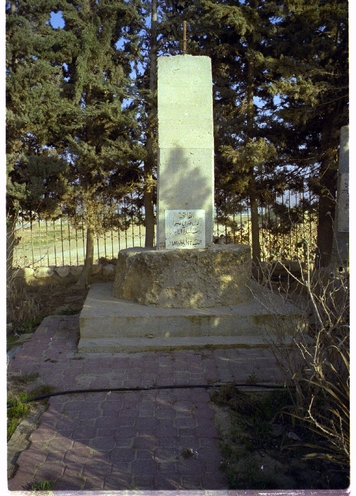
The memorial to the Sabra/Shatila massacre, Lakiya, Nagab Photo: R.Sayigh
|
 The memorial to the Sabra/Shatila massacre, Lakiya, Nagab Photo: R.Sayigh |
Alayan al-Sanaa, Lakiya, March 28:
|
|
In the evening Hassan takes me to meet an older man he respects, who was among the first batch of Lakiya boys to get a modern education, which meant leaving the Nagab and staying in Tireh, a town in central Israel ('the Triangle'). This trip takes us to a newly constructed part of the village: 2-storey homes built of stone, with walls and painted woodwork, iron gates and fenced gardens. I've already heard talk about the debts people are running up to build homes, and how none of the building contractors are local people but come either from Israel or the West Bank. It isn't clear to me why Alayan Sanaa should live in a solid house like this rather than the more widespread Lakiya model of a mixture of wood, corrugated iron, and plastic sheeting. Maybe it's a matter of how savings are invested and family resources.
Hassan tells me that Alayan was a teacher but lost his post years ago, after imprisonment for 'clandestine activities'. Since then he's been a community activist, and founder of the 'Lakiya Educational Society'. He speaks more as an Arab nationalist than as a bedouin citizen of Israel claiming equal rights, a position he accuses of being 'sectarian'. Because of his activism, he married late, and the small boy sitting on his lap as he speaks looks too young to be the son of a man of fifty.
|
Alayan al-Saana begins speaking:
"We transferred to Tireh village, a group of youngsters. We became young men of the generation of the secondary school. There was the secondary school and we finished there, we became the first generation faced with changes and new social circumstances. We rented a house there, and we looked after ourselves. We cooked food, we did the laundry - men! We finished secondary - (How many were you from Lakiya?) We were about five. From Tell Arad. Two of the group have died, two are left. One has been living in the Netherlands since 1977. Another left for the Netherlands and came back and is working now in Tell Sabaa. He is married to a Palestinian woman from the Bethlehem area, and for more than five years he couldn't get her an ID card from the Israeli authorities, because before she was an immigrant from Khulda village east of Ramleh. After we left [Tireh] there was an initiative from us, from Tell Arad as well as another group that joined us, Tarabeen (?), from another part of Nagab who aspired to education ...The year we finished our education was 1967. In June we had to do our exams, and there was the war, and there was the defeat, and there was the disaster - after the disaster of 1948. It shook us to our roots. All that was left of Palestine came under Zionist control..." |
[Hajji Umm Ibrahim al-Sanaa] [Rahat] Copyright©2005 |
|